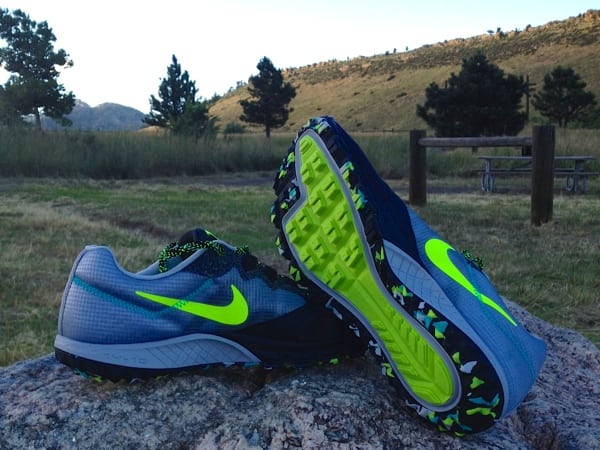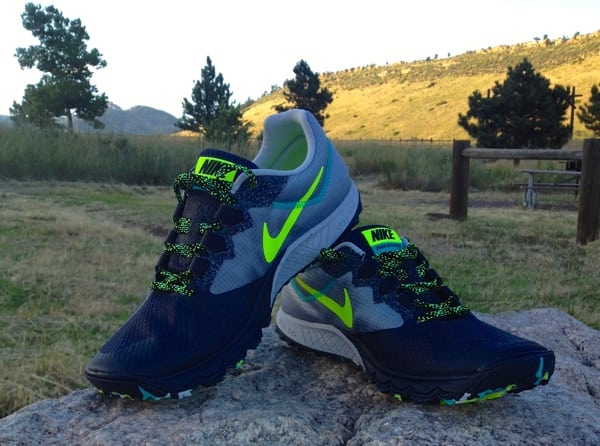Check out our Nike Wildhorse 10 review for the latest on the Wildhorse family of trail running shoes.
Our Favorite Trail Running Shoes
Check out our Best Trail Running Shoes article to learn about our current favorite trail running shoes!
Nike Zoom Wildhorse 2 Review
When I first opened the box with my Nike Zoom Wildhorse 2 ($110) shoes, I was pleasantly surprised by their aesthetics. I’m a sucker for trail running shoes that incorporate a good amount of greys and blacks into the color scheme, mostly to hide the dirt and (not so) occasional blood from knee scrapes that comes with my Colorado mountain running.

The Nike Zoom Wildhorse 2.
The pair I tested was Wolf Grey/Dark Ash/Hyper Jade/Volt in a men’s size 8. A size 9 weighs in at 9.3 ounces, which places them smack in the middle of my near-complete personal Salomon shoe line. These are a neutral shoe with minimal support, so if you’re an overpronator, you may want to look elsewhere.
[Editor’s Note: This review was conducted by guest reviewer Heather Jossi.]
Upper
Nike uses the Dynamic Fit system, which is a supportive inner sleeve that wraps under the arch and around the midfoot for better arch support and a secure, yet non-restrictive fit. The toe box is seamless, making this shoe one of the most comfortable shoes I’ve ever worn. Nike describes the fabric in the roomy toe-box as “open mesh,” but it’s not the mesh you think of. It’s woven quite tightly and I never had an issue with dirt or sand entering the shoe in that area.
The Wildhorse also uses an EVA sockliner and Stobel last. The lacing system is standard; the laces are flat, and their fabric is such that a double knot isn’t required. I found the fit to be secure and very comfortable. If I was a sockless runner, these would be my go-to shoes. The toe bumper has been streamlined from the first edition, resulting in the low height, but combined with the fabric, doesn’t restrict wiggle room.

Midsole
The full length Phylon midsole foam with the Crash Pad and Zoom Air in the heel gives adequate protection for most trail conditions. To me, the ride felt semi-firm to firm, and I liked that the shoe felt responsive. I did find the torsional stiffness to be a bit lacking on canted or deep-grooved singletrack, and I don’t think the shoe has enough protection for me on technical trails, but I’m not always the most nimble-footed runner.

Outsole
Nike uses a variety of substantial and well-thought out tread patterns to give this shoe impressive grip. The placement of the Waffle-pattern square lugs under the forefoot and front of the midfoot gives really good bite into whatever surface you happen to be on. The rear midfoot and heel sport reverse arrow lugs which are perfect for downhill running. Around the outside of the sole are smaller, triangular lugs which really complement the top-notch grip. The Environmentally Preferred sticky rubber allowed the shoe to perform well in dirt and sand. It also provides great grip on wet rocks. I was most pleased with the way they handled snow. I had good traction and they also shed the slush that usually wedges and remains between the lugs.

Opinions
The first time I tried the shoes on, I was impressed by how comfortable they were with and without socks. I felt like I had been wearing them for a few weeks because of how they hugged my feet. I did find that if I wore my standard medium-weight Merino wool running socks, these shoes were a tad snug. Knowing that, I’d prefer to have a size 8.5, but with a lighter-weight sock, the size 8’s felt just fine.
This shoe has a 4mm drop (22 heel/18 forefoot), and I really like the way my foot is low to the ground but still feels supported. Even though the toe box is low height, I never felt like my toes were cramped. The toe box is also seamless, which my pinky toes really appreciate! I was pleased with the grip of the shoes and felt secure on all of the surfaces I ran on.
I didn’t have a chance to do any water crossings, so I can’t speak for the shoe’s ability to drain, but my guess is that with the density of the fabric used, there may be more water retention than other shoes on the market that sport more open mesh. I also didn’t get to wallow in mud, so I’m not sure if the shoe will shed that, but honestly, I’ve never found a shoe that didn’t collect four inches of the stuff that you find on Colorado’s Front Range.
For me, this shoe is the perfect for non-technical, rolling singletrack. They aren’t stiff enough for the steep, rocky trails that I frequent, and I prefer a little more rock protection. The Wildhorse 2’s would be great for a trail half, but I’m not sure I could run a full marathon distance without wanting a bit more protection and support.
These shoes are perfect for the nimble midfoot striker. I’m still transitioning to the midfoot strike and I’m finding these are great training shoes since they definitely encourage that gait.
Bottom Line
The Nike Zoom Wildhorse 2’s definitely have a place in my line-up of shoes. At $110, the price may be a tad steep, but let’s be honest, shoes that cost less than a Ben Franklin are a thing of the past. I think Nike did a great job in making a lightweight, low-profile, neutral shoe that will give you a comfortable ride and fantastic grip on most trails.
[Editor’s Note: You can also check out our review of the original Nike Zoom Wildhorse.]
Call for Comments (from Meghan)
- Have you tried the Nike Zoom Wildhorse 2’s yet? If so, what are your impressions of them?
- Have you worn both the original Nike Zoom Wildhorse as well as this second model? If so, how would you describe the updates made to the shoe?
- For those of you who’ve run in the range of Nike models, what are your thoughts on the Wildhorse’s place within it?
